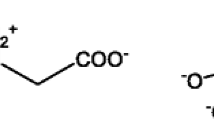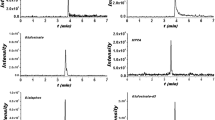Abstract
Glyphosate is currently the most widely used herbicide in the world, yet screening of environmental waters for this chemical is limited by the need for specialized derivatization and measurement methods that can be tedious and time-consuming. In this work, we present a novel method for the detection and quantification at trace levels of glyphosate and aminomethylphosphonic acid (AMPA) in environmental water samples. The detection and quantification of the analytes was performed by liquid chromatography (LC) coupled with tandem mass spectrometry (MS/MS). Chromatographic separation was achieved with an ion-exchange column and a pH-gradient elution of a solution of ammonium hydroxide and ammonium acetate. The limit of detection for glyphosate and AMPA was 0.25 μg L-1 and the limit of quantification was 0.5 μg L-1with a 20-μL injection. The method was used to investigate the levels of glyphosate and AMPA in surface water samples from the Yarra River catchment area and urban constructed stormwater wetlands. The results indicate that at the time of sampling, no glyphosate or AMPA was present in the samples from the Yarra River catchment area (n = 10). However, glyphosate was detected above the limit of quantification in 33% of the wetland samples (n = 12), with concentrations ranging from 1.95 to 2.96 μg L-1. Similarly, AMPA was quantified in 83% of the wetland samples, with concentrations ranging from 0.55 to 2.42 μg L-1. To our knowledge, this is the first report of a pH-gradient LC–MS/MS method for glyphosate and AMPA analysis at ultratrace levels, with minimal sample processing, avoiding costly, time-consuming derivatization and preconcentration steps.

ᅟ





Similar content being viewed by others
References
Benbrook CM. Trends in glyphosate herbicide use in the United States and globally. Environ Sci Eur. 2016;28:3.
Australian Pesticides and Veterinary Medicines Authority. Public Chemical Registration Information System. 2018. https://portal.apvma.gov.au/pubcris?p_auth=vQ5V7spW&p_p_id=pubcrisportlet_WAR_pubcrisportlet&p_p_lifecycle=1&p_p_state=normal&p_p_mode=view&p_p_col_id=column-1&p_p_col_pos=2&p_p_col_count=4&_pubcrisportlet_WAR_pubcrisportlet_javax.portlet.action=search. Accessed 30 Jan 2018.
Primost JE, Marino DJG, Aparicio VC, Costa JL, Carriquiriborde P. Glyphosate and AMPA, “pseudo-persistent” pollutants under real-world agricultural management practices in the Mesopotamic Pampas agroecosystem, Argentina. Environ Pollut. 2017;229:771–9.
Battaglin WA, Meyer MT, Kuivila KM, Dietze JE. Glyphosate and its degradation product AMPA occur frequently and widely in U.S. soils, surface water, groundwater, and precipitation. JAWRA. J Am Water Resour Assoc. 2014;50(2):275–90.
Poiger T, Buerge IJ, Bächli A, Müller MD, Balmer ME. Occurrence of the herbicide glyphosate and its metabolite AMPA in surface waters in Switzerland determined with on-line solid phase extraction LC-MS/MS. Environ Sci Pollut Res. 2017;24(2):1588–96.
Pérez DJ, Okada E, De Gerónimo E, Menone ML, Aparicio VC, Costa JL. Spatial and temporal trends and flow dynamics of glyphosate and other pesticides within an agricultural watershed in Argentina. Environ Toxicol Chem. 2017;36(12):3206–16.
Okada E, Pérez D, De Gerónimo E, Aparicio V, Massone H, Costa JL. Non-point source pollution of glyphosate and AMPA in a rural basin from the southeast pampas, Argentina. Environ Sci Pollut Res. 2018;25(15):15120–32.
Bento PM, Goossens D, Rezaei M, Riksen M, Mol HGJ, Ritsema CJ, et al. Glyphosate and AMPA distribution in wind-eroded sediment derived from loess soil. Environ Pollut. 2017;220:1079–89.
Yang X, Wang F, Bento CPM, Xue S, Gai L, Dam R Van, et al. Short-term transport of glyphosate with erosion in Chinese loess soil — a flume experiment. Sci Total Environ. 2015;512–513:406–414.
Stalikas CD, Konidari CN. Analytical methods to determine phosphonic and amino acid group-containing pesticides. J Chromatogr A. 2001;907(1–2):1–19.
Ghanem A, Bados P, Kerhoas L, Dubroca J, Einhorn J. Glyphosate and AMPA analysis in sewage sludge by LC-ESI-MS/MS after FMOC derivatization on strong anion-exchange resin as solid support. Anal Chem. 2007;79(10):3794–801.
Koskinen WC, Marek LJ, Hall KE. Analysis of glyphosate and aminomethylphosphonic acid in water, plant materials and soil. Pest Manag Sci. 2016;72(3):423–32.
Jámbor A, Molnár-Perl I. Amino acid analysis by high-performance liquid chromatography after derivatization with 9-fluorenylmethyloxycarbonyl chloride: Literature overview and further study. J Chromatogr A. 2009;1216(15):3064–77.
Botero-Coy AM, Ibáñez M, Sancho JV, Hernández F. Direct liquid chromatography-tandem mass spectrometry determination of underivatized glyphosate in rice, maize and soybean. J Chromatogr A. 2013;1313:157–65.
Hanke I, Singer H, Hollender J. Ultratrace-level determination of glyphosate, aminomethylphosphonic acid and glufosinate in natural waters by solid-phase extraction followed by liquid chromatography-tandem mass spectrometry: performance tuning of derivatization, enrichment and detection. Anal Bioanal Chem. 2008;391(6):2265–76.
Hao C, Morse D, Morra F, Zhao X, Yang P, Nunn B. Direct aqueous determination of glyphosate and related compounds by liquid chromatography/tandem mass spectrometry using reversed-phase and weak anion-exchange mixed-mode column. J Chromatogr A. Elsevier B.V. 2011;1218(33):5638–43.
Nagatomi Y, Yoshioka T, Yanagisawa M, Uyama A, Mochizuki N. Simultaneous LC-MS/MS analysis of glyphosate, glufosinate, and their metabolic products in beer, barley tea, and their ingredients. Biosci Biotechnol Biochem. 2013;77(11):2218–21.
Guo H, Riter LS, Wujcik CE, Armstrong DW. Direct and sensitive determination of glyphosate and aminomethylphosphonic acid in environmental water samples by high performance liquid chromatography coupled to electrospray tandem mass spectrometry. J Chromatogr A. 2016;1443:93–100.
Department of Environment, Land, Water and Planning. Catchment Management Authority boundaries. 2018. https://www.data.vic.gov.au/data/dataset/catchment-management-authority-boundaries.Accessed 15 Jan 2018.
National Health and Medical Research Council, National Resource Management Ministerial Council. Australian drinking water guidelines paper 6 national water quality management strategy. Canberra: National Health and Medical Research Council and National Resource Management Ministerial Council; 2011.
Australian and New Zealand Environment and Conservation Council, Agriculture and Resource Management Council of Australia and New Zealand. Australian and New Zealand guidelines for fresh and marine water quality. 2000. p. 1–103.
European Union. Council Directive 91/414/EEC. Brussels: European Union; 1991.
Environmental Protection Agency. 2002 edition of the drinking water standards and health advisories. EPA 822-R-02-038. Washington: US Environmental Protection Agency; 2002. p. 12.
Federal-Provincial-Territorial Committee on Drinking Water of the Federal-Provincial-Territorial Committee on Health and the Environment. Guidelines for Canadian drinking water quality. 2014. https://www.canada.ca/en/health-canada/services/environmental-workplace-health/reports-publications/water-quality/guidelines-canadian-drinking-water-quality-summary-table.html. Accessed 13 Oct 2018.
Environmental Protection Agency. Aquatic life benchmarks and ecological risk assessments for registered pesticides. https://www.epa.gov/pesticide-science-and-assessing-pesticide-risks/aquatic-life-benchmarks-and-ecological-risk#ref_2. Accessed 7 Oct 2018.
Canadian Council of Ministers of the Environment. Appendix V—Canadian water quality guidelines: updates (September 1989), carbofuran, glyphosate, and atrazine. In: Canadian water quality guidelines. Canadian Council of Resource and Environment Ministers. Task Force on Water Quality Guidelines; 1989.
World Health Organization. Environmental health criteria 159. Geneva: World Health Organization; 1994.
Borggaard OK, Gimsing AL. Fate of glyphosate in soil and the possibility of leaching to ground and surface waters : a review. Pest Manag Sci. 2008;456:441–56.
Mahler BJ, Van Metre PC, Burley TE, Loftin KA, Meyer MT, Nowell LH. Similarities and differences in occurrence and temporal fluctuations in glyphosate and atrazine in small Midwestern streams (USA) during the 2013 growing season. Sci Total Environ. 2017;579:149–58.
Mauffrey F, Baccara PY, Gruffaz C, Vuilleumier S, Imfeld G. Bacterial community composition and genes for herbicide degradation in a stormwater wetland collecting herbicide runoff. Water Air Soil Pollut. 2017;228(12):452.
Tang T, Boënne W, Desmet N, Seuntjens P, Bronders J, Van Griensven A. Quantification and characterization of glyphosate use and loss in a residential area. Sci Total Environ. 2015;517:207–14.
Acknowledgements
E.O. holds an Endeavour Research Fellowship (5911-2017) from the Department of Education and Training of the Australian Government. The authors thank Agilent Technologies for technical assistance with instrument setup and operation.
Author information
Authors and Affiliations
Corresponding author
Ethics declarations
Conflict of interest
The authors declare that they have no competing interests.
Additional information
Publisher’s Note
Springer Nature remains neutral with regard to jurisdictional claims in published maps and institutional affiliations.
Rights and permissions
About this article
Cite this article
Okada, E., Coggan, T., Anumol, T. et al. A simple and rapid direct injection method for the determination of glyphosate and AMPA in environmental water samples. Anal Bioanal Chem 411, 715–724 (2019). https://doi.org/10.1007/s00216-018-1490-z
Received:
Revised:
Accepted:
Published:
Issue Date:
DOI: https://doi.org/10.1007/s00216-018-1490-z




